北师版(2019)必修第三册Unit 9 Learning Lesson 3 The Secrets of Your Memory 课件(共26张PPT)
文档属性
| 名称 | 北师版(2019)必修第三册Unit 9 Learning Lesson 3 The Secrets of Your Memory 课件(共26张PPT) |
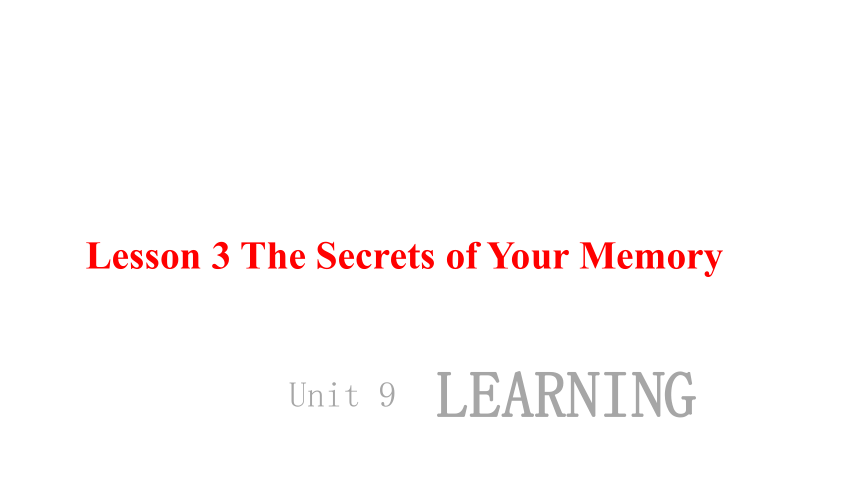
|
|
| 格式 | pptx | ||
| 文件大小 | 88.7KB | ||
| 资源类型 | 教案 | ||
| 版本资源 | 北师大版(2019) | ||
| 科目 | 英语 | ||
| 更新时间 | 2024-03-26 10:26:40 | ||
图片预览

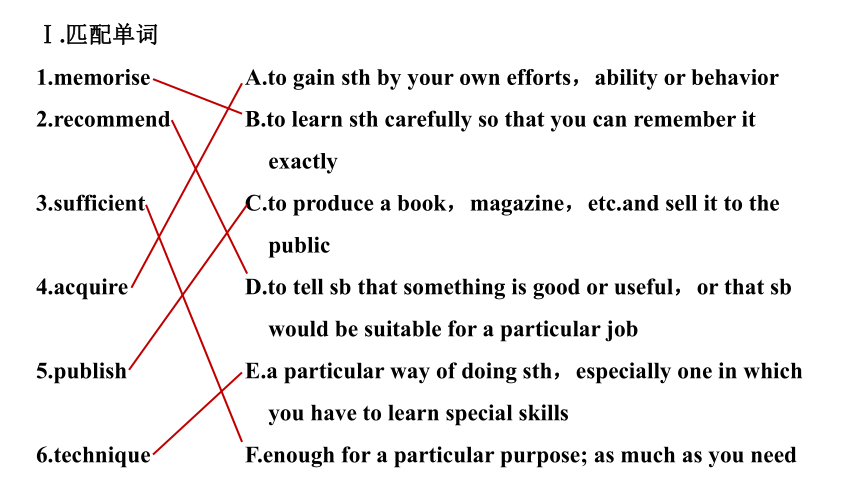
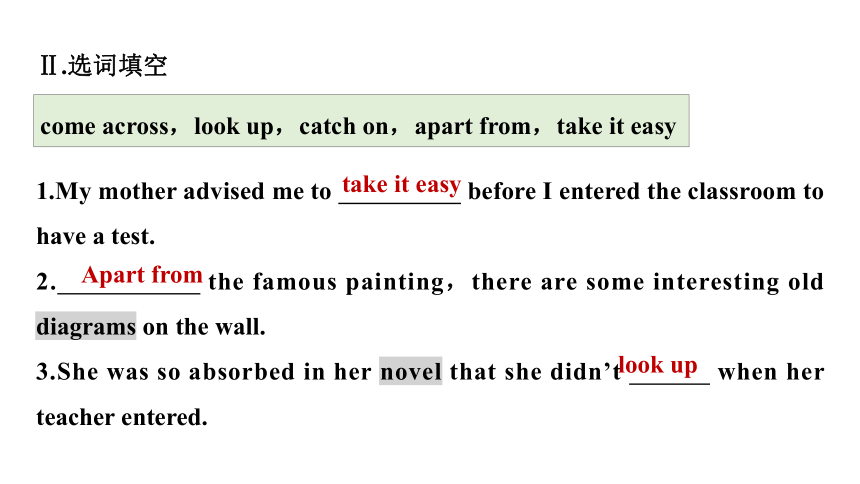
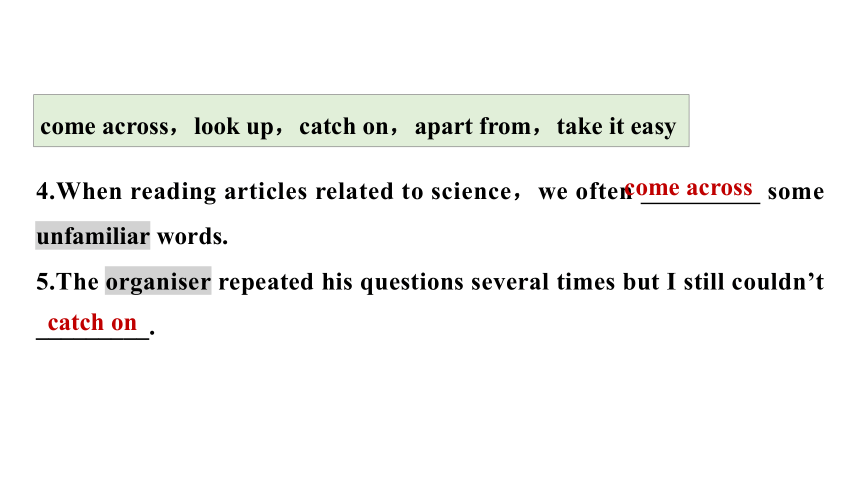
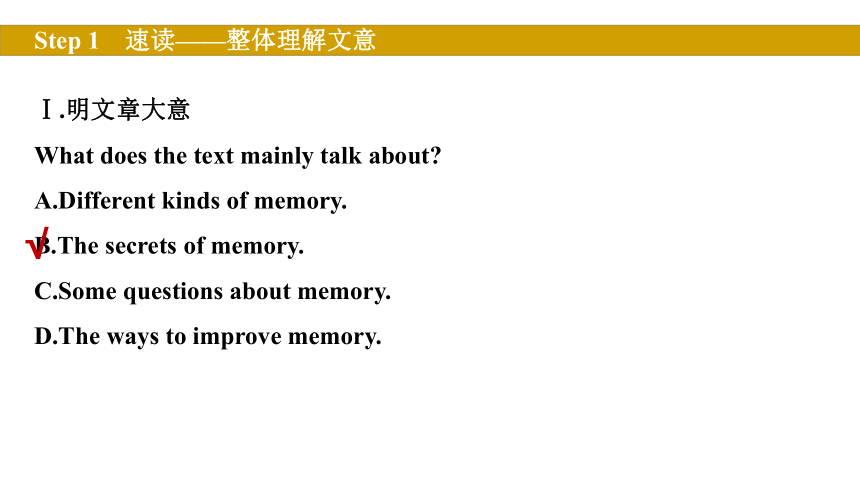
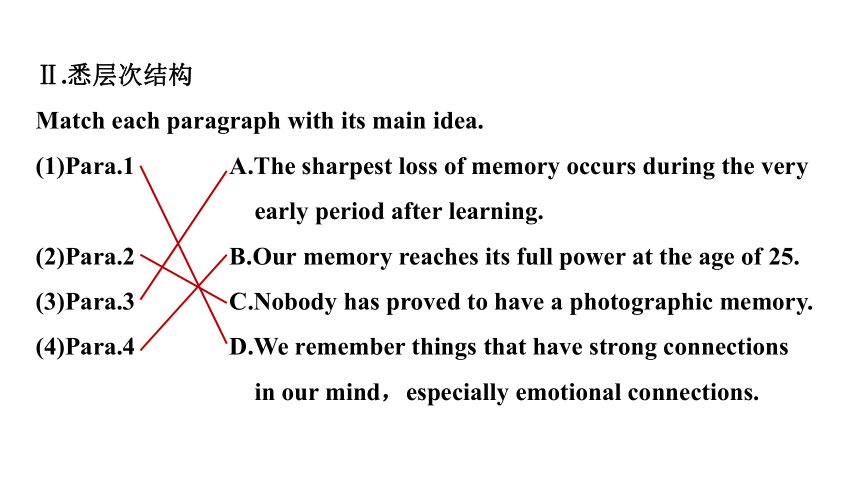


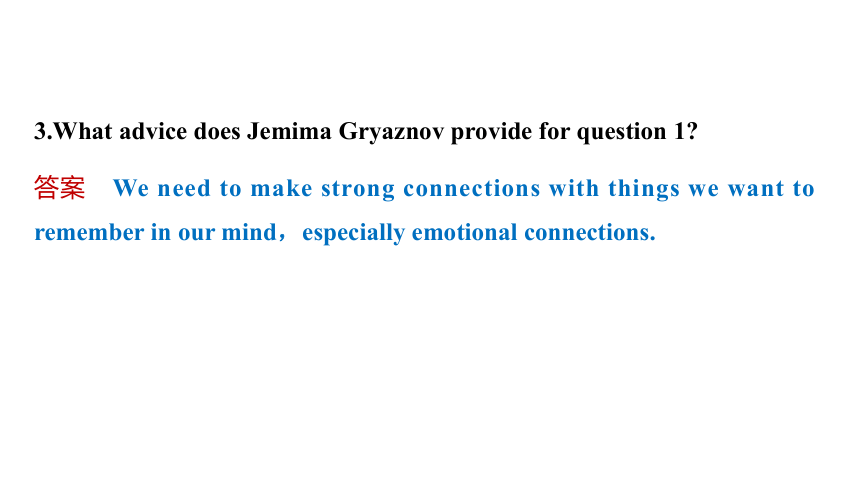
文档简介
(共26张PPT)
Unit 9
LEARNING
Lesson 3 The Secrets of Your Memory
Ⅰ.匹配单词
1.memorise A.to gain sth by your own efforts,ability or behavior
2.recommend B.to learn sth carefully so that you can remember it
exactly
3.sufficient C.to produce a book,magazine,etc.and sell it to the
public
4.acquire D.to tell sb that something is good or useful,or that sb
would be suitable for a particular job
5.publish E.a particular way of doing sth,especially one in which
you have to learn special skills
6.technique F.enough for a particular purpose; as much as you need
Ⅱ.选词填空
come across,look up,catch on,apart from,take it easy
1.My mother advised me to before I entered the classroom to have a test.
2. the famous painting,there are some interesting old diagrams on the wall.
3.She was so absorbed in her novel that she didn’t when her teacher entered.
take it easy
Apart from
look up
come across,look up,catch on,apart from,take it easy
4.When reading articles related to science,we often some unfamiliar words.
5.The organiser repeated his questions several times but I still couldn’t _________.
come across
catch on
Ⅰ.明文章大意
What does the text mainly talk about
A.Different kinds of memory.
B.The secrets of memory.
C.Some questions about memory.
D.The ways to improve memory.
√
Step 1 速读——整体理解文意
Ⅱ.悉层次结构
Match each paragraph with its main idea.
(1)Para.1 A.The sharpest loss of memory occurs during the very
early period after learning.
(2)Para.2 B.Our memory reaches its full power at the age of 25.
(3)Para.3 C.Nobody has proved to have a photographic memory.
(4)Para.4 D.We remember things that have strong connections
in our mind,especially emotional connections.
Ⅰ.Read para.1 and do the following exercises.
1.When we remember something new,try to connect it to .
A.our hobbies B.our training
C.our emotions D.our thoughts
Step 2 细读——逐段获取细节
√
2.Decide whether the following statements are T(true) or F(false) and correct the false information.
(1)We remember certain events in our childhood,because we experienced many of them for the first time,and we felt strongly about them at the time.( )
(2)When we tell a story many times,we forget important details.( )
T
F
答案 When we tell a story many times,we can remember it clearly.
3.What advice does Jemima Gryaznov provide for question 1
答案 We need to make strong connections with things we want to remember in our mind,especially emotional connections.
Ⅱ.Read para.2 and do the following exercises.
1.Who can remember the first 22,514 digits of pi (π)
A.Stephen Wiltshire.
B.Daniel Tammet.
C.Jemima Gryaznov.
D.Hermann Ebbinghaus.
√
2.Why does the writer give the examples of Daniel Tammet and Stephen Wiltshire
A.To prove some people have photographic memories.
B.To show us they are both good at memorising figures.
C.To show they are both good at remembering particular things for a
limitless time.
D.To prove that some people have amazing memories.
√
Ⅲ.Read para.3 and do the following exercises.
1.If Tony has learnt a passage,during which time should he review it to get efficient memory
A.The first day. B.Five days later.
C.One week later. D.Immediately.
√
2.What should we do to remember the information we have learnt
答案 We need to review the information at regular intervals,especially in the first day after learning it.
Ⅳ.Read para.4 and do the following exercises.
1.Who has the best memory
A.George at the age of 16.
B.Miss Young at the age of 27.
C.Mr Yang at the age of 25.
D.Dr.Li at the age of 40.
√
2.How many brain cells do we lose by the age of 40
A.1,000. B.100,000.
C.1000,000. D.10,000.
√
3.How does the author develop this paragraph
A.By listing examples.
B.By making comparisons.
C.By listing numbers.
D.By citing famous quotes.
√
Ⅴ.Read the whole passage again and do the following exercises.
1.What is the type of the passage
A.Narration(记叙文).
B.Argumentative essay(议论文).
C.Expository writing(说明文).
D.Practical writing(应用文).
√
2.Which section of a newspaper does the text probably come from
A.Entertainment. B.Biology.
C.Health. D.Career.
√
3.The expert has used some methods to make her statements convincing EXCEPT .
A.examples B.quotes
C.comparisons D.graphs
√
1.Why are childhood memories often very emotional (Critical thinking)
2.Suppose one of your friends has some difficulties in memorising what he has learnt.Can you give him some tips for improving his memory?(Creative thinking)
Step 3 读后——讨论深度理解
Step 4 总结——课文语法填空
We remember things that have strong connections in our mind,especially 1. (emotion) connections.So it is important to connect something new with 2. we already know.Also,we can try to retell what we have learnt to a few others.
A person with a photographic memory could remember every detail of a picture,a book or an event many 3. (year) later,but no one has proved that there are people 4. really have photographic memories.So we simply need to focus on the important ideas and be curious about what we learn when 5. (memorise) detailed learning materials.
emotional
what
years
who/that
memorising
According to Ebbinghaus,the sharpest 6. (lose) of memory occurs during the very early period after learning.Therefore,one of the golden rules to increase how much we remember 7. (be) to review the material 8. (periodical),especially during the first day after learning.
Our memory reaches its full power 9. the age of 25.After this age,the brain starts to get smaller.By middle age,our memory is significantly 10. (bad) than when we were young.
loss
is
periodically
at
worse
Step 5 解读——长句难句分析
1.This is because when we experience things for the first time,we often have strong feelings of fear or excitement.
[句式分析] 本句是 句。because引导的是 从句,其中when引导 从句。
[自主翻译] ___________________________________________________
_______________________________________________________________
主从复合
表语
时间状语
这是因为我们第一次经历事物时,常常会产生强烈的恐惧感或者兴奋感。
2.A person with a photographic memory could remember every detail of a picture,a book or an event many years later,but no one has proved that there are people who really have photographic memories.
[句式分析] 本句是 句。but连接两个并列分句,第一个分句中with短语作 ,修饰a person;第二个分句中的that引导
从句;who引导 从句,修饰 。
[自主翻译] ___________________________________________________
______________________________________________________________________________________________________________________________
并列主从复合
后置定语
宾语
定语
people
拥有照相记忆能力的人多年后仍旧可以记住某一张图片、某本书或者某一事件的每一个细节,但没有人能证明真有哪个人有照相记忆能力。
3.As most of us do not have amazing memories like them,when memorising detailed learning materials,we simply need to focus on the important ideas and be curious about what we learn.
[句式分析] 本句是 句。As引导 从句;when memorising...是 的省略;what 引导 从句。
[自主翻译] ___________________________________________________
______________________________________________________________________________________________________________________________
主从复合
原因状语
状语从句
宾语
大多数人并不具有他们那样惊人的记忆力,因此我们在尝试记学习内容的细节时,仅需把注意力放到概要方面,并对所学内容保持好奇。
4.Another effective technique to remember things is to group similar ideas or information together so that they can be easily connected to things that are already known.
[句式分析] 本句是 句。so that引导 从句;主句中的不定式短语to remember things作 ,修饰 ,不定式短语to group...together作 ;that are already known是 从句,修饰 。
[自主翻译] ___________________________________________________
_______________________________________________________________
主从复合
目的状语
后置定语
technique
表语
定语
things
另外一个有效的记忆方法是给相似的内容或信息分类,这样这些内容能更容易与已有知识建立联系。
Unit 9
LEARNING
Lesson 3 The Secrets of Your Memory
Ⅰ.匹配单词
1.memorise A.to gain sth by your own efforts,ability or behavior
2.recommend B.to learn sth carefully so that you can remember it
exactly
3.sufficient C.to produce a book,magazine,etc.and sell it to the
public
4.acquire D.to tell sb that something is good or useful,or that sb
would be suitable for a particular job
5.publish E.a particular way of doing sth,especially one in which
you have to learn special skills
6.technique F.enough for a particular purpose; as much as you need
Ⅱ.选词填空
come across,look up,catch on,apart from,take it easy
1.My mother advised me to before I entered the classroom to have a test.
2. the famous painting,there are some interesting old diagrams on the wall.
3.She was so absorbed in her novel that she didn’t when her teacher entered.
take it easy
Apart from
look up
come across,look up,catch on,apart from,take it easy
4.When reading articles related to science,we often some unfamiliar words.
5.The organiser repeated his questions several times but I still couldn’t _________.
come across
catch on
Ⅰ.明文章大意
What does the text mainly talk about
A.Different kinds of memory.
B.The secrets of memory.
C.Some questions about memory.
D.The ways to improve memory.
√
Step 1 速读——整体理解文意
Ⅱ.悉层次结构
Match each paragraph with its main idea.
(1)Para.1 A.The sharpest loss of memory occurs during the very
early period after learning.
(2)Para.2 B.Our memory reaches its full power at the age of 25.
(3)Para.3 C.Nobody has proved to have a photographic memory.
(4)Para.4 D.We remember things that have strong connections
in our mind,especially emotional connections.
Ⅰ.Read para.1 and do the following exercises.
1.When we remember something new,try to connect it to .
A.our hobbies B.our training
C.our emotions D.our thoughts
Step 2 细读——逐段获取细节
√
2.Decide whether the following statements are T(true) or F(false) and correct the false information.
(1)We remember certain events in our childhood,because we experienced many of them for the first time,and we felt strongly about them at the time.( )
(2)When we tell a story many times,we forget important details.( )
T
F
答案 When we tell a story many times,we can remember it clearly.
3.What advice does Jemima Gryaznov provide for question 1
答案 We need to make strong connections with things we want to remember in our mind,especially emotional connections.
Ⅱ.Read para.2 and do the following exercises.
1.Who can remember the first 22,514 digits of pi (π)
A.Stephen Wiltshire.
B.Daniel Tammet.
C.Jemima Gryaznov.
D.Hermann Ebbinghaus.
√
2.Why does the writer give the examples of Daniel Tammet and Stephen Wiltshire
A.To prove some people have photographic memories.
B.To show us they are both good at memorising figures.
C.To show they are both good at remembering particular things for a
limitless time.
D.To prove that some people have amazing memories.
√
Ⅲ.Read para.3 and do the following exercises.
1.If Tony has learnt a passage,during which time should he review it to get efficient memory
A.The first day. B.Five days later.
C.One week later. D.Immediately.
√
2.What should we do to remember the information we have learnt
答案 We need to review the information at regular intervals,especially in the first day after learning it.
Ⅳ.Read para.4 and do the following exercises.
1.Who has the best memory
A.George at the age of 16.
B.Miss Young at the age of 27.
C.Mr Yang at the age of 25.
D.Dr.Li at the age of 40.
√
2.How many brain cells do we lose by the age of 40
A.1,000. B.100,000.
C.1000,000. D.10,000.
√
3.How does the author develop this paragraph
A.By listing examples.
B.By making comparisons.
C.By listing numbers.
D.By citing famous quotes.
√
Ⅴ.Read the whole passage again and do the following exercises.
1.What is the type of the passage
A.Narration(记叙文).
B.Argumentative essay(议论文).
C.Expository writing(说明文).
D.Practical writing(应用文).
√
2.Which section of a newspaper does the text probably come from
A.Entertainment. B.Biology.
C.Health. D.Career.
√
3.The expert has used some methods to make her statements convincing EXCEPT .
A.examples B.quotes
C.comparisons D.graphs
√
1.Why are childhood memories often very emotional (Critical thinking)
2.Suppose one of your friends has some difficulties in memorising what he has learnt.Can you give him some tips for improving his memory?(Creative thinking)
Step 3 读后——讨论深度理解
Step 4 总结——课文语法填空
We remember things that have strong connections in our mind,especially 1. (emotion) connections.So it is important to connect something new with 2. we already know.Also,we can try to retell what we have learnt to a few others.
A person with a photographic memory could remember every detail of a picture,a book or an event many 3. (year) later,but no one has proved that there are people 4. really have photographic memories.So we simply need to focus on the important ideas and be curious about what we learn when 5. (memorise) detailed learning materials.
emotional
what
years
who/that
memorising
According to Ebbinghaus,the sharpest 6. (lose) of memory occurs during the very early period after learning.Therefore,one of the golden rules to increase how much we remember 7. (be) to review the material 8. (periodical),especially during the first day after learning.
Our memory reaches its full power 9. the age of 25.After this age,the brain starts to get smaller.By middle age,our memory is significantly 10. (bad) than when we were young.
loss
is
periodically
at
worse
Step 5 解读——长句难句分析
1.This is because when we experience things for the first time,we often have strong feelings of fear or excitement.
[句式分析] 本句是 句。because引导的是 从句,其中when引导 从句。
[自主翻译] ___________________________________________________
_______________________________________________________________
主从复合
表语
时间状语
这是因为我们第一次经历事物时,常常会产生强烈的恐惧感或者兴奋感。
2.A person with a photographic memory could remember every detail of a picture,a book or an event many years later,but no one has proved that there are people who really have photographic memories.
[句式分析] 本句是 句。but连接两个并列分句,第一个分句中with短语作 ,修饰a person;第二个分句中的that引导
从句;who引导 从句,修饰 。
[自主翻译] ___________________________________________________
______________________________________________________________________________________________________________________________
并列主从复合
后置定语
宾语
定语
people
拥有照相记忆能力的人多年后仍旧可以记住某一张图片、某本书或者某一事件的每一个细节,但没有人能证明真有哪个人有照相记忆能力。
3.As most of us do not have amazing memories like them,when memorising detailed learning materials,we simply need to focus on the important ideas and be curious about what we learn.
[句式分析] 本句是 句。As引导 从句;when memorising...是 的省略;what 引导 从句。
[自主翻译] ___________________________________________________
______________________________________________________________________________________________________________________________
主从复合
原因状语
状语从句
宾语
大多数人并不具有他们那样惊人的记忆力,因此我们在尝试记学习内容的细节时,仅需把注意力放到概要方面,并对所学内容保持好奇。
4.Another effective technique to remember things is to group similar ideas or information together so that they can be easily connected to things that are already known.
[句式分析] 本句是 句。so that引导 从句;主句中的不定式短语to remember things作 ,修饰 ,不定式短语to group...together作 ;that are already known是 从句,修饰 。
[自主翻译] ___________________________________________________
_______________________________________________________________
主从复合
目的状语
后置定语
technique
表语
定语
things
另外一个有效的记忆方法是给相似的内容或信息分类,这样这些内容能更容易与已有知识建立联系。
同课章节目录
- Unit 7 Art
- Lesson 1 Masterpieces
- Lesson 2 Beijing Opera
- Lesson 3 A Musical Genius
- Unit 8 Green living
- Lesson 1 Roots and Shoots
- Lesson 2 Greening the Desert
- Lesson 3 "White Bikes" on the Road
- Unit 9 Learning
- Lesson 1 Active Learning
- Lesson 2 Language Learning Tips
- Lesson 3 The Secrets of Your Memory
